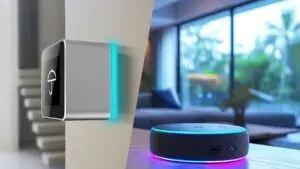Top Smart Home Gadgets are no longer luxury—they are tools that truly simplify daily life. In this article, you will discover smart home gadgets, smart home devices, and home automation tools that save time, energy, and stress. You will learn how to pick, install, and use them in easy steps. You will read about real devices tested in 2025—not vague promises. You get clear advice, features, comparison tables, case study snapshots, and 5 common FAQs answered. This is your guide to transforming living rooms, kitchens, security, climate, and more with the best smart home gadgets available today.
1. What Makes a Gadget “Smart”?
A smart gadget must do more than respond to a button. It must connect, sense, and act. A smart gadget usually has automation: it can act on rules (if this, then that). It supports connectivity (Wi-Fi, Bluetooth, Zigbee, or the newer Matter standard) so it can communicate. Many support voice control (Alexa, Google Assistant, Siri).
Devices fit into ecosystems. For example, a smart bulb can join Apple HomeKit or Amazon Alexa. A standard LED just turns on or off. A smart bulb can dim on schedule, change color, or respond to presence detection. When gadgets talk to each other, your home reacts without your constant input.
2. Benefits of Smart Home Gadgets
Smart gadgets bring four main benefits. First, convenience: your lights turn on automatically at dusk, your vacuum runs while you are out, your coffee machine is ready when you step in. These small automations free your mind.
Second, energy efficiency: a smart thermostat learns your schedule and reduces heating or cooling when no one’s home. Many users report 10–25 % lower energy bills by using smart thermostats with sensors.
Third, security enhancements: cameras, smart locks, and motion sensors give real-time alerts. Some use AI to reduce false alarms—ignoring swaying trees or pets.
Fourth, accessibility and independence: for seniors or people with disabilities, these devices let them control locks, lights, or appliances by voice or app, avoiding physical tasks.
A fact: households using smart thermostats can save on average about 15 % on heating and cooling across a year.
3. Best Smart Home Gadgets in 2025 (By Category)
4.A Smart Lighting
In 2025, Philips Hue still leads with robust software, wide third-party support, and multiroom control. Nanoleaf panels offer decorative lighting that also functions as ambient indicators. These lighting systems allow scheduling, scenes, rhythms tied to sunrise/sunset. They often use Zigbee or Matter to reduce Wi-Fi load. You can dim, color shift, or automate based on motion or time. Compared to traditional lights, smart lighting may cost more upfront but yields energy saving and ambiance.
4.B Smart Thermostats
The Google Nest Thermostat is intuitive, with learning behavior and remote control. Ecobee SmartThermostat includes built-in sensors and voice assistant. You can compare real cost over a year. Suppose your cooling bill is $100 monthly; with a smart thermostat, a 15 % saving gives $15 per month, or $180 yearly. Over multiple years, the upfront cost is recouped.
4.C Smart Security Devices
A video doorbell like Ring or Nest Hello allows you to see visitors and speak to them. Security cameras have AI detection—focusing on people rather than motion blur. Smart locks from brands like August or Yale let you lock/unlock via app or code. Some locks auto-lock when you leave. Combined, these improve your home protection while cutting false alerts.
4.D Smart Speakers and Displays
Devices such as Amazon Echo Show, Google Nest Hub, and Apple HomePod Mini act as voice control centers. You can ask to turn on lights, see camera feeds, adjust thermostat, or listen to music. These speakers integrate with many devices and bring hands-free control. They serve as the hub of your system—your voice triggers routines across devices.
4.E Smart Cleaning Devices
Robot vacuums and mops, like iRobot Roomba j-Series or Roborock S8, map your home using cameras and LiDAR. They avoid obstacles and clean more efficiently. Some models know to avoid carpets during mopping. These devices do hours of work you would otherwise do. But they require occasional maintenance: emptying bins, cleaning brushes, updating maps.
4.F Smart Kitchen Appliances
In the kitchen, devices like smart refrigerators, ovens, or coffee makers sync into routines. A smart coffee maker can begin brewing when your morning alarm goes off. A smart refrigerator can notify you of low supplies, track expiration, or integrate with shopping lists. You can build a morning automation: lights on, coffee ready, thermostat set to comfortable temperature. That kind of orchestration turns separate gadgets into a unified smart home experience.
4. How to Choose the Right Smart Devices
First, check compatibility: if your system is built on Alexa, Google, or Apple, buy devices that support that ecosystem. Mixing incompatible brands can lead to a fragmented, hard-to-manage setup.
Second, examine connectivity and power: devices may rely on Wi-Fi (heavy traffic) or Zigbee / Matter (lighter and more reliable). Some need wired power or PoE; battery-powered models mean occasional replacement.
Third, consider data privacy and firmware updates. A smart device must receive security patches. Check the manufacturer’s track record.
Fourth, avoid common mistakes: too many apps, too many brands, or lack of central control. It is better to pick a few device types and maintain a coherent system rather than buying everything at once and ending with chaos.
5. Installation and Setup Tips
Many devices are plug-and-play: plug them in, follow the app steps, and they join your network. Others (smart switches or security wiring) may need electrician help.
Once devices are online, build automation routines. For example, create a “Goodnight” routine: at 10 pm, lights dim or turn off, doors lock, thermostat lowers, cameras activate. That one routine triggers multiple devices.
A real-life example: Sarah set her “Leaving home” routine. When she taps “Goodbye” in her app, lights switch off, thermostat shifts to eco mode, smart lock activates, and security cameras turn on. This single tap handles six actions. Over time, she added voice triggers and geofencing such that the same happens when she leaves home.
6. Future Trends in Smart Home Technology
The Matter protocol is rising. It ensures different brand devices speak the same language. That reduces compatibility issues.
We will see AI-driven predictive automation. Devices will anticipate needs: lights shift before you think, energy use optimized per weather forecasts.
Smart homes will increasingly tie with energy grids. During peak electricity demand, your devices will adjust consumption to support sustainable, efficient power use. Your home becomes part of a smart grid.
7. Common Issues and Troubleshooting
A frequent issue is connectivity dropouts. If a device drops off Wi-Fi, check signal strength, router capacity, or move it closer to a hub or repeater. Use mesh Wi-Fi or Zigbee repeaters.
Privacy concerns arise when devices stream video or data. Change default passwords. Enable two-factor authentication. Use a separate IoT network.
“App fatigue” is common: too many device apps. Consolidate control using hubs or unified apps. Use routines or voice to avoid opening multiple apps each time.
Conclusion
Smart home gadgets in 2025 can genuinely make life easier. They save your time, cut energy bills, increase safety, and reduce manual work. Begin small: pick one or two devices, like a smart bulb or thermostat, and build your system from there. Over time, you can expand confidently. The main keywords—smart home gadgets—are not mere trends but tools you live with daily. Take one small step now, and your home will gradually transform into a responsive, caring partner.
Top Smart Home Gadgets Comparison Table
| Category | Device Example | Key Feature | Ecosystem / Protocol |
| Lighting | Philips Hue | Scene & color control | Zigbee / Matter / Wi-Fi |
| Thermostat | Google Nest | Learning and remote control | Wi-Fi / Thread |
| Security | Ring Video Doorbell | Live video & alerts | Wi-Fi / Local storage |
| Speaker / Hub | Amazon Echo Show | Display + voice control | Alexa / Matter |
| Cleaning | Roborock S8 | Mapping & vacuum/mop combo | Wi-Fi / LiDAR |
| Kitchen | Smart Coffee Maker | Scheduled brew | Wi-Fi / App control |
Costs & Savings Table
| Device | Approx Cost in 2025 (USD) | Annual Savings / Benefit |
| Smart Thermostat | 150 – 250 | 10-25 % on heating/cooling |
| Smart Bulb (Color) | 30 – 60 | Lower energy use, longer life |
| Robot Vacuum | 300 – 700 | Hours saved per week |
| Smart Lock | 100 – 200 | No locksmith visits, better safety |
| Video Doorbell | 150 – 250 | Prevent theft & package loss |
| Smart Coffee Maker | 120 – 220 | Time saved, convenience boost |
Case Study: The Khan Family in Karachi
Mr. Khan and his family installed a basic smart setup: two smart bulbs, one smart plug, and a video doorbell. They use Google Home ecosystem. After six months, their electricity bill dropped by 12 %. Their security incidents (false alarms, missing packages) reduced. They later added a smart thermostat and robot vacuum. Today, their home responds: when they leave, everything turns off; when they return, lights come on, home warms, and music plays. Their incremental approach avoided overwhelm and now gives them a smart, cohesive system.
FAQs
Q1: Can smart home gadgets work without internet?
Yes, some devices use local protocols (Zigbee, Matter, or Bluetooth) and can function within your home network without cloud. But remote access and voice assistant features often need internet.
Q2: Do smart devices use a lot of electricity?
They use some standby power, but usually negligible compared to the savings they bring (e.g. thermostat reduces HVAC load). Good devices have efficient standby modes.
Q3: Are smart home devices safe from hackers?
They can be vulnerable. Use strong passwords, update firmware, segment networks, enable encryption, and turn off unused features.
Q4: How many devices can a single smart hub support?
It depends on the hub’s hardware. Many support 50–100 devices. Important is to know your hub’s limits and use repeaters or mesh to expand.
Q5: Is it expensive to upgrade entire home to smart?
It can be if done at once. But starting small (one room, one device) spreads cost. Over years, energy and convenience returns often offset expenses.
Meta Description
Discover the best smart home gadgets in 2025. Learn to pick, install, and use smart home gadgets to simplify life with real tips and device reviews.





